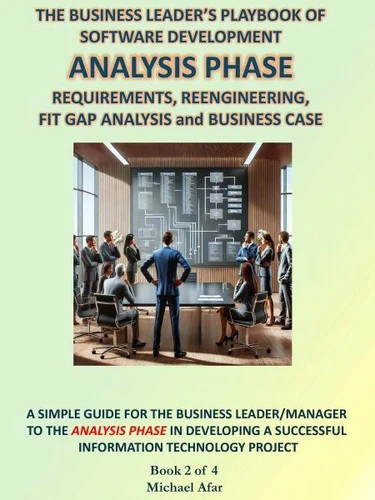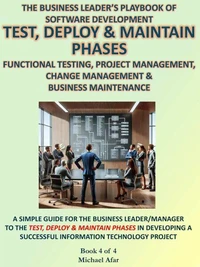Analysis Phase. The Business Leader's Playbook of Software Development, #2
Par :Formats :
Disponible dans votre compte client Decitre ou Furet du Nord dès validation de votre commande. Le format ePub est :
- Compatible avec une lecture sur My Vivlio (smartphone, tablette, ordinateur)
- Compatible avec une lecture sur liseuses Vivlio
- Pour les liseuses autres que Vivlio, vous devez utiliser le logiciel Adobe Digital Edition. Non compatible avec la lecture sur les liseuses Kindle, Remarkable et Sony
 , qui est-ce ?
, qui est-ce ?Notre partenaire de plateforme de lecture numérique où vous retrouverez l'ensemble de vos ebooks gratuitement
Pour en savoir plus sur nos ebooks, consultez notre aide en ligne ici
- FormatePub
- ISBN8231559503
- EAN9798231559503
- Date de parution30/06/2025
- Protection num.pas de protection
- Infos supplémentairesepub
- ÉditeurWalzone Press
Résumé
The Analysis Phase of the Software Development Life Cycle (SDLC) is a crucial step where business objectives are translated into technical requirements. In this comprehensive guide, business professionals will gain the necessary insights to collaborate effectively with consultants and technical teams. The book begins with an overview of the SDLC, including an essential glossary and a clear introduction to the Information Technology Project Phases.
Key topics include how AI can be leveraged, the role of business requirements, use cases, and business process reengineering, offering detailed guidance on identifying and redesigning efficient processes. Practical tools such as templates for business requirements documents, business process review, and fit-gap analysis are offered. The book equips leaders with the knowledge to conduct Business Fit Gap Analysis, evaluate flows and functional requirements, and assess data models to ensure alignment between business needs and technical capabilities.
Additionally, it provides insights into system fit-gap analysis, including technical aspects like XML schemas and database definitions. Finally, business leaders will learn how to craft a solid business case that aligns strategic objectives with technical solutions, ensuring successful project outcomes. With this book, business leaders will have the confidence to lead during the analysis phase and collaborate effectively with technical staff, ultimately driving success in their IT projects.
The Table of Contents of the book comprises:Impact of AI on SDLC1. System Development Phases2. Analysis Phase A. Overview of the Analysis Phase B. About Use Cases 2.1 Business Requirements, Business Process Review & Reengineering 2.1.1 Business Requirements 2.1.2 Business Process Review 2.1.3 Reengineering 2.1.3.1 Identify the Process 2.1.3.2 Analyze the Process 2.1.3.3 Design the New Process 2.1.3.4 Implement the New Processes 2.1.3.5 Monitor and Measure the Results 2.1.3.6 Continuous Improvement 2.2 Business Fit Gap Analysis 2.2.1 Flows and Functional Requirements 2.2.2 Data Subject Areas, Entities & Attributes 2.3 System Fit Gap Analysis 2.3.1 Physical And Logical Data Models 2.3.2 XML Schemas, Database Definitions, Interface Files 2.4. Business CaseAppendix A - Use CasesAppendix B - Business Requirements DocumentAppendix C - Business Process Review TemplateAppendix D - Monitoring and Measuring ResultsAppendix E - Fit Gap AnalysisAppendix F - Business Case Templates Included in the BookTemplates are provided for the development of Use Cases, Business Requirements Document, and Business Process Review, ensuring a structured approach to analyzing and documenting business needs.
Additionally, the book includes templates for Monitoring and Measuring Results, allowing leaders to track progress and performance effectively. The Fit Gap Analysis template helps identify discrepancies between current capabilities and desired outcomes, while the Business Case template provides a clear framework for justifying project investments and aligning them with organizational goals.
Key topics include how AI can be leveraged, the role of business requirements, use cases, and business process reengineering, offering detailed guidance on identifying and redesigning efficient processes. Practical tools such as templates for business requirements documents, business process review, and fit-gap analysis are offered. The book equips leaders with the knowledge to conduct Business Fit Gap Analysis, evaluate flows and functional requirements, and assess data models to ensure alignment between business needs and technical capabilities.
Additionally, it provides insights into system fit-gap analysis, including technical aspects like XML schemas and database definitions. Finally, business leaders will learn how to craft a solid business case that aligns strategic objectives with technical solutions, ensuring successful project outcomes. With this book, business leaders will have the confidence to lead during the analysis phase and collaborate effectively with technical staff, ultimately driving success in their IT projects.
The Table of Contents of the book comprises:Impact of AI on SDLC1. System Development Phases2. Analysis Phase A. Overview of the Analysis Phase B. About Use Cases 2.1 Business Requirements, Business Process Review & Reengineering 2.1.1 Business Requirements 2.1.2 Business Process Review 2.1.3 Reengineering 2.1.3.1 Identify the Process 2.1.3.2 Analyze the Process 2.1.3.3 Design the New Process 2.1.3.4 Implement the New Processes 2.1.3.5 Monitor and Measure the Results 2.1.3.6 Continuous Improvement 2.2 Business Fit Gap Analysis 2.2.1 Flows and Functional Requirements 2.2.2 Data Subject Areas, Entities & Attributes 2.3 System Fit Gap Analysis 2.3.1 Physical And Logical Data Models 2.3.2 XML Schemas, Database Definitions, Interface Files 2.4. Business CaseAppendix A - Use CasesAppendix B - Business Requirements DocumentAppendix C - Business Process Review TemplateAppendix D - Monitoring and Measuring ResultsAppendix E - Fit Gap AnalysisAppendix F - Business Case Templates Included in the BookTemplates are provided for the development of Use Cases, Business Requirements Document, and Business Process Review, ensuring a structured approach to analyzing and documenting business needs.
Additionally, the book includes templates for Monitoring and Measuring Results, allowing leaders to track progress and performance effectively. The Fit Gap Analysis template helps identify discrepancies between current capabilities and desired outcomes, while the Business Case template provides a clear framework for justifying project investments and aligning them with organizational goals.
The Analysis Phase of the Software Development Life Cycle (SDLC) is a crucial step where business objectives are translated into technical requirements. In this comprehensive guide, business professionals will gain the necessary insights to collaborate effectively with consultants and technical teams. The book begins with an overview of the SDLC, including an essential glossary and a clear introduction to the Information Technology Project Phases.
Key topics include how AI can be leveraged, the role of business requirements, use cases, and business process reengineering, offering detailed guidance on identifying and redesigning efficient processes. Practical tools such as templates for business requirements documents, business process review, and fit-gap analysis are offered. The book equips leaders with the knowledge to conduct Business Fit Gap Analysis, evaluate flows and functional requirements, and assess data models to ensure alignment between business needs and technical capabilities.
Additionally, it provides insights into system fit-gap analysis, including technical aspects like XML schemas and database definitions. Finally, business leaders will learn how to craft a solid business case that aligns strategic objectives with technical solutions, ensuring successful project outcomes. With this book, business leaders will have the confidence to lead during the analysis phase and collaborate effectively with technical staff, ultimately driving success in their IT projects.
The Table of Contents of the book comprises:Impact of AI on SDLC1. System Development Phases2. Analysis Phase A. Overview of the Analysis Phase B. About Use Cases 2.1 Business Requirements, Business Process Review & Reengineering 2.1.1 Business Requirements 2.1.2 Business Process Review 2.1.3 Reengineering 2.1.3.1 Identify the Process 2.1.3.2 Analyze the Process 2.1.3.3 Design the New Process 2.1.3.4 Implement the New Processes 2.1.3.5 Monitor and Measure the Results 2.1.3.6 Continuous Improvement 2.2 Business Fit Gap Analysis 2.2.1 Flows and Functional Requirements 2.2.2 Data Subject Areas, Entities & Attributes 2.3 System Fit Gap Analysis 2.3.1 Physical And Logical Data Models 2.3.2 XML Schemas, Database Definitions, Interface Files 2.4. Business CaseAppendix A - Use CasesAppendix B - Business Requirements DocumentAppendix C - Business Process Review TemplateAppendix D - Monitoring and Measuring ResultsAppendix E - Fit Gap AnalysisAppendix F - Business Case Templates Included in the BookTemplates are provided for the development of Use Cases, Business Requirements Document, and Business Process Review, ensuring a structured approach to analyzing and documenting business needs.
Additionally, the book includes templates for Monitoring and Measuring Results, allowing leaders to track progress and performance effectively. The Fit Gap Analysis template helps identify discrepancies between current capabilities and desired outcomes, while the Business Case template provides a clear framework for justifying project investments and aligning them with organizational goals.
Key topics include how AI can be leveraged, the role of business requirements, use cases, and business process reengineering, offering detailed guidance on identifying and redesigning efficient processes. Practical tools such as templates for business requirements documents, business process review, and fit-gap analysis are offered. The book equips leaders with the knowledge to conduct Business Fit Gap Analysis, evaluate flows and functional requirements, and assess data models to ensure alignment between business needs and technical capabilities.
Additionally, it provides insights into system fit-gap analysis, including technical aspects like XML schemas and database definitions. Finally, business leaders will learn how to craft a solid business case that aligns strategic objectives with technical solutions, ensuring successful project outcomes. With this book, business leaders will have the confidence to lead during the analysis phase and collaborate effectively with technical staff, ultimately driving success in their IT projects.
The Table of Contents of the book comprises:Impact of AI on SDLC1. System Development Phases2. Analysis Phase A. Overview of the Analysis Phase B. About Use Cases 2.1 Business Requirements, Business Process Review & Reengineering 2.1.1 Business Requirements 2.1.2 Business Process Review 2.1.3 Reengineering 2.1.3.1 Identify the Process 2.1.3.2 Analyze the Process 2.1.3.3 Design the New Process 2.1.3.4 Implement the New Processes 2.1.3.5 Monitor and Measure the Results 2.1.3.6 Continuous Improvement 2.2 Business Fit Gap Analysis 2.2.1 Flows and Functional Requirements 2.2.2 Data Subject Areas, Entities & Attributes 2.3 System Fit Gap Analysis 2.3.1 Physical And Logical Data Models 2.3.2 XML Schemas, Database Definitions, Interface Files 2.4. Business CaseAppendix A - Use CasesAppendix B - Business Requirements DocumentAppendix C - Business Process Review TemplateAppendix D - Monitoring and Measuring ResultsAppendix E - Fit Gap AnalysisAppendix F - Business Case Templates Included in the BookTemplates are provided for the development of Use Cases, Business Requirements Document, and Business Process Review, ensuring a structured approach to analyzing and documenting business needs.
Additionally, the book includes templates for Monitoring and Measuring Results, allowing leaders to track progress and performance effectively. The Fit Gap Analysis template helps identify discrepancies between current capabilities and desired outcomes, while the Business Case template provides a clear framework for justifying project investments and aligning them with organizational goals.





